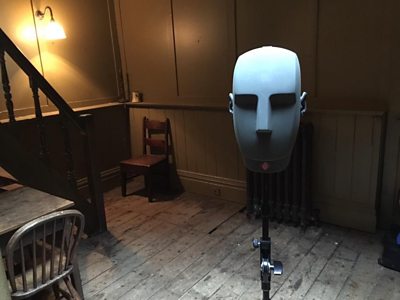
This Halloween is on Radio 4. Two brilliant new adaptations of cult horror classics will be broadcast: Ring, based on the Japanese novel and well known in film adaptations, and The Stone Tape, based on the 1972 TV film by Nigel Kneale. We have worked with the production teams of both dramas to create special binaural headphone mixes - trying to make them even more intense and spooky.
You can listen to and in binaural both online and in the iPlayer Radio app from Saturday 31st October for 30 days.
It's been great to work on this project and I'm really pleased with the end results. In this post Catherine Robinson who did the sound design and mixing for Ring gives a little insight into the production process.
Binaural sound gives more creative possibilities for sound scenes by recreating the cues we use in natural hearing, particularly binaural cues i.e. the differences between the two ears. The ΒιΆΉΤΌΕΔ is very interested in the technology because it gives a chance to enhance the sound of our programmes for those listening on headphones, which is more common than ever thanks to the use of mobile devices.
We've extensively worked on evaluating tools and techniques for creating binaural sound, as well as developing some of our own technology. This is an exciting moment for our and a great opportunity to put our binaural production tools to the test.
The two plays are quite different in style and the differing approaches to recording and mixing them reflect that. They both feature amazing sound design, which has been great to work with. We took the completed stereo productions and remixed them into 3D sound scenes using our binaural processing software. We used a few additional recordings that were made on location with a dummy head microphone, as shown in the picture below from Tony Churnside. There are also some elements in the mixes that are still in stereo or even mono, for example in The Stone Tape when recordings are played back on the Nagra reel-to-reel recorder.

Mixing Ring in Binaural
Catherine Robinson talks about her experience of mixing Ring in binaural with ΒιΆΉΤΌΕΔ R&D...
"Iβve been very excited about the immersive audio research and work that has been going on in ΒιΆΉΤΌΕΔ R&D so I jumped at the chance to mix an immersive radio drama with Chris Pike, Frank Melchior and the object-based audio technology. The only other experience I have had with binaural audio was recording soundscapes with in-ear binaural microphones on my travels. I called them sound postcards and I really loved the immersive experience of popping my headphones on, playing back my recordings, closing my eyes and I was instantly transported back to that place. This was very different however, a fabricated binaural process created from many objects or sounds.
The genre of βRingβ is horror which I felt would be a good genre to experience immersive audio. From the outset I was guided by Frank and Chris in R&D. Usually, when I record drama in stereo I would arrange the actors around a stereo pair and they would move quite naturally in the space to exploit the sense of space and movement within the stereo image. But for this project it was preferable to get the actors on separate mono mics so the movement could be created using the binaural software, giving greater control. I also borrowed the Neumann binaural dummy head which was useful in achieving very close whispering in-ear effects. The main hurdle I had to get over during the recording process was to get the actors to work in such a different way when they have been used to working and moving to a stereo pair. They now had to move and vocalise their actions on the spot which felt unnatural at first.
When we got to the edit we knew that the drama had to work in stereo as well as in the binaural mix so we concentrated on the getting the stereo right but keeping in mind that the streams needed to be arranged separately in preparation for the immersive mix. This particular drama was very sound design heavy and rich in action.
The binaural mixing process had an unexpected impact for me on the mix. The space put around the sounds revealed things we couldnβt hear before which were masked in the stereo mix. The end result gives the overall feel of a much more realistic space which is a great effect but the sound is taken somehow beyond your head. The stereo version is more intimate and grounding. I think we did get some extremely good results with the binaural effects on the abstract sound design moving around you. The whispering in the ears gave a chill up my spine and there were moments when the mix sounded so real that I thought it was happening in the room I was sat in. This technology is incredible used on the right production and I would really like to see an immersive mix available for a television programme, perhaps available on the red button. It could even be a special headphone immersive mix responding to those watching on their tablets. Not only that but we are hurtling towards the release of virtual reality headsets for gamers. I think there will be a desire to create content on these devices in the future, content recorded on 360 camera rigs. Immersive audio will become an essential element of this content and Iβm very excited to see it develop in this direction."
How to listen to Fright Night in binaural
The binaural mixes will be available online and in the iPlayer Radio app, in addition to the stereo versions broadcast on Radio 4. ΒιΆΉΤΌΕΔ programmes are avaiable at a range of bitrates, what you get depends upon your device and network bandwidth. For the best quality I recommend streaming using a desktop computer connected to WiFi or downloading the programme before listening. I also recommend using the highest quality headphones you have available to you and sitting in a quiet and preferrably dark environment. This will ensure that you can hear the full detail (and horror) in these binaural mixes.
Listen to in binaural
Listen to in binaural
Try the Ring interactive trailer
More information on how to listen is available .
P.S. A little trivia for you, apparently Nigel Kneale was inspired to write The Stone Tape after a visit to ΒιΆΉΤΌΕΔ R&D's former home , which is where I started my ΒιΆΉΤΌΕΔ career.
